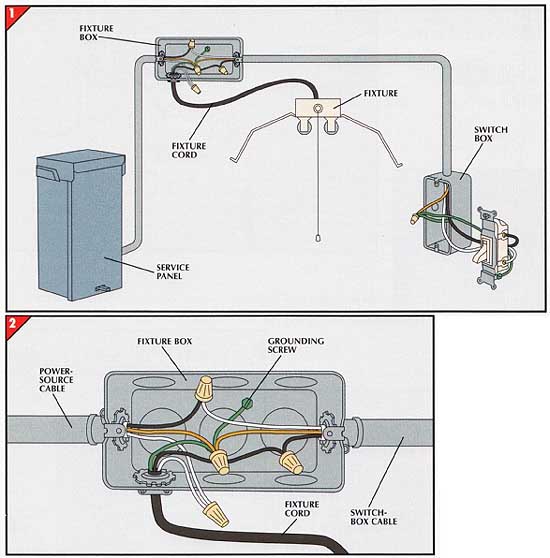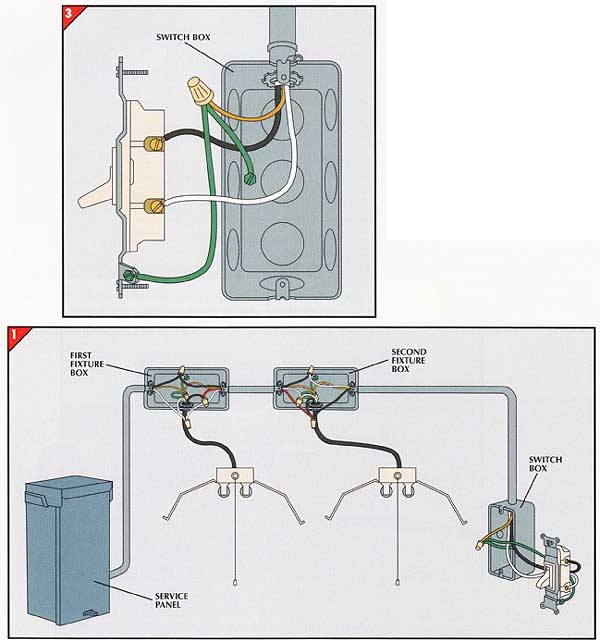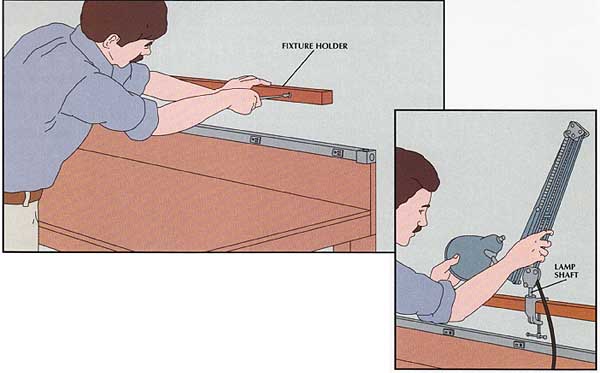Workshops need two kinds of light: general overhead lighting and light aimed directly on the work at hand. The first need is met by permanent fixtures; the second is best served by a portable plug-in fixture.
Fluorescent Lighting: An ideal fluorescent fixture for the shop consists of two 40-watt tubes 4 feet long mounted in a metal box incorporating a reflector, a ballast trans former, wiring, and four lamp holders. The lighting unit can be mounted directly to a low ceiling, or hung on chains where a ceiling is higher.
Switches: Fixtures can be con trolled by switches mounted directly on the units, by wall switches, or by both. Wall switches for overhead lights are wired in one of two ways. In middle-of-the-line wiring, the switch is placed between the power source and the light fixture and the power goes from source to fixture in a direct line. A fixture that lies between the source and the switch is wired with a switch loop—the power goes first to the fixture outlet box, where it is diverted to the switch and back to the fixture via the same cable. If you are wiring two or more lights in a circuit controlled by one end-of-line switch, run three-conductor-with- ground cable between the fixtures.
Portable Light: Lamps that direct light where it is needed come in both incandescent and fluorescent designs. The extension-arm light clamps onto almost any bench and has a mounting shaft that can be fitted into a hole drilled in the workbench or a tool stand, so the fixture can be moved quickly from one spot to another.
TOOLS:
- Ball-peen hammer
- Punch
- Cable ripper
- Wire strippers
- Diagonal-cutting pliers
- Screwdriver
- Electric drill
- Masonry bit
- Carpenter’s level
MATERIALS:
- Electrical cord
- Cable clamps
- Wire caps
- Fluorescent light fixture
- Pull-chain switch
- Lightweight chain
- S-hooks
- Screw eyes
- Outlet boxes
- Conduit and fittings
- Electrical cable
- Green jumper wire
- Light switch
- 2 x 2
- Screw anchors
- Wood screws (3” No. 8)
SAFETY TIPS: When working overhead or when drilling or nailing, protect your eyes with goggles.
HANGING A SWITCHED FLUORESCENT FIXTURE
• Strip 6 inches of sheathing from one end of a spool of Type SJ No. 16 three-wire flexible cord; strip the wire ends. Secure a cable clamp to the box, slide the cord through a knockout hole in the fixture, and fasten it with the clamp.
• Secure the cord’s green wire to the grounding screw of the box.
• With wire caps, join the white cord wire to the white fixture wire and, unless you are adding a switch to the fixture (Step 2), connect the black cord wire to the black fixture wire.
• Assemble the rest of the fixture following the manufacturer’s instructions.

2. Adding a switch to the fixture.
• To control the light with a pull-chain switch mounted on the fixture, fasten the black cord wire to one of the switch wires. Fasten the other switch wire to the black fixture wire.
• Insert the switch into a knockout hole in the fixture’s end plate and secure the switch with its retaining nut.

3. Hanging the fixture.
• With diagonal-cutting pliers cut four equal lengths of lightweight chain to hang the fixture at the desired height.
• Attach one chain to each of the openings in the top of the fixture with S-hooks.
• Twist screw eyes into the joists above the work area. Slip S-hooks into the free end of each chain and hang the fixture from the screw eyes. To adjust the height of the fixture, reposition the chain links on the upper S-hooks.
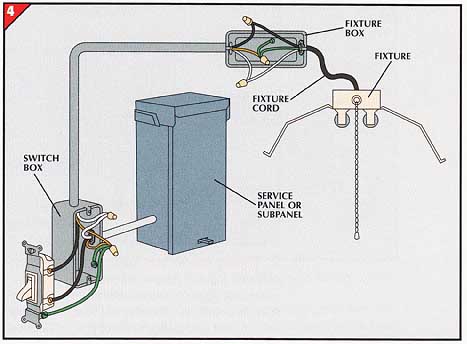
4. Running power to the fixture.
• Install an outlet box for the light switch and another one near the fixture. Run conduit and No. 14 two- conductor-with-ground cable from the main service panel or a subpanel to the switch box, then continue with another cable to the fixture box.
• Fasten a length of green jumper wire to the green grounding screws in both boxes and to the switch.
• At the switch box, connect the bare wires of the two cables to the green jumper wires with wire caps. Connect the white wires of the cables together, and the two black cable wires to separate switch terminals.
• At the fixture box, join the green jumper wire, the bare cable wire, and the green cord wire with a wire cap.
Connect the white cable wire to the white cord wire and the black cable wire to the black cord wire.
WIRING AN END-OF-LINE SWITCH
The diagram above shows the wiring layout for a fixture box with a light switch. In an end-of-line circuit (above), cable is first run from the service panel to the fixture box. The fixture is wired to the box and another run of cable extends to the switch box.
• Run conduit and No. 14 two-conductor-with- ground cable from the service panel or subpanel to a fixture box near the light fixture; run a second cable with conduit from the box to another box at the light-switch location.
• Wire the light fixture with Type SJ No. 16 three-wire flexible cord (Step 1) and clamp the fixture cord to the fixture box.
2. Wiring the fixture box.
• Fasten a green jumper wire to the grounding screw of the fixture box.
• With a wire cap, connect the bare wires of the two cables to the green wire of the fixture cord and the green jumper wire.
• Connect the white wire of the power-source cable to the fixture cord’s white wire.
• Join the black wire of the power- source cable to the white wire of the cable going to the switch box.
• Connect the black wire of the switch-box cable to the black wire of the fixture cord.
• Attach a green jumper wire to the grounding screw in the box and another to the green grounding terminal on the switch strap.
• At the switch box, join the bare ground wire of the cable to the two jumper wires.
• Connect the black and white cable wires to separate terminals on the switch. Mount the light switch in the switch box and add the cover.
A SWITCH LOOP THAT RUNS THROUGH TWO FIXTURES
1. Layout of a two-fixture run.
The diagram above shows the wiring for two light fixtures controlled from a single switch. Power from the service panel passes through the first fixture box, on to the second through three-conductor cable, and to the switch. It returns to the second box and then to its fixture. Without three-conductor cable between the fixture boxes the switch could control only the second fixture; the first would be on regardless of the switch position.
• Hang the fixtures over the work area, then install a fixture box near each one. Join the fixtures to the boxes with flexible cord (Step 1).
• Install conduit and cable as for a simple one-fixture switch loop (Step 1), but use three-conductor with-ground cable between the two fixture boxes.
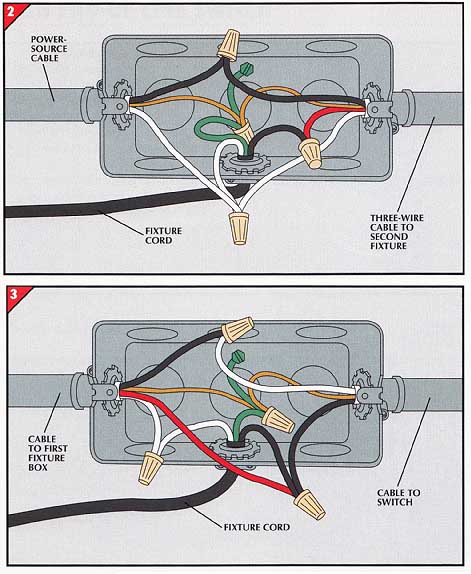
2. Wiring the first fixture box.
• At the first fixture box, attach a green jumper wire to the grounding screw
• Connect the bare wires of the two cables to the green jumper wire and the green wire of the fixture cord with a wire cap.
• Connect the white wire of the cable from the power source, the white wire going to the second fixture box, and the white wire from the fixture cord.
• Join the black wires of the two cables.
• Connect the black wire of the fixture cord to the red wire of the cable going to the second fixture box.
3. Wiring the second fixture box.
• Fasten a green jumper wire to the grounding screw in the second fixture box.
• With a wire cap connect the bare wires of the two cables to the green jumper, and the green wire of the fixture cord.
• Connect the black wire of the cable from the first fixture box to the white wire of the cable going to the switch.
• Join the white wire of the cable from the first fixture box to the white wire from the fixture cord.
• Connect the red wire of the cable from the first fixture box, the black fixture-cord wire, and the black wire from the cable going to the switch.
• Wire the switch (Step 3).
SPOTLIGHTING A WORKBENCH
• Draw a level screw-hole line on the wall 9 inches above the table.
• For a concrete wall, as shown here, drill holes for screw anchors at 1 -foot intervals along the line. Insert the anchors.
• Drill corresponding clearance holes along the centerline of a 2-by-2, then secure it with 3-inch No. 8 screws.
• Fasten the lamp’s clamp to the 2-by-2, then fit the lamp in place (inset).
If there is a stud wall behind the bench, nail the strip to each stud with 3½” common nails.
== A Bench Dog for Lamp Support ==
A workbench with “dog holes” along one edge of the top enables you to fit the holes with metal bench dogs and then clamp a large workpiece between a dog and the vise. You can also use the square dog holes to sup port a lamp. Bore a hole the same diameter as the lamp shaft into the end of a wood block cut to fit the holes. Position the light at any of the holes along the bench.
If your bench doesn’t have dog holes you can bore a hole in a hardwood block and clamp it in the bench vise.
==
Next: BENCHES, JIGS, AND ACCESSORIES: Intro and Building
a Workbench
Prev: Routing Power through
the Shop

